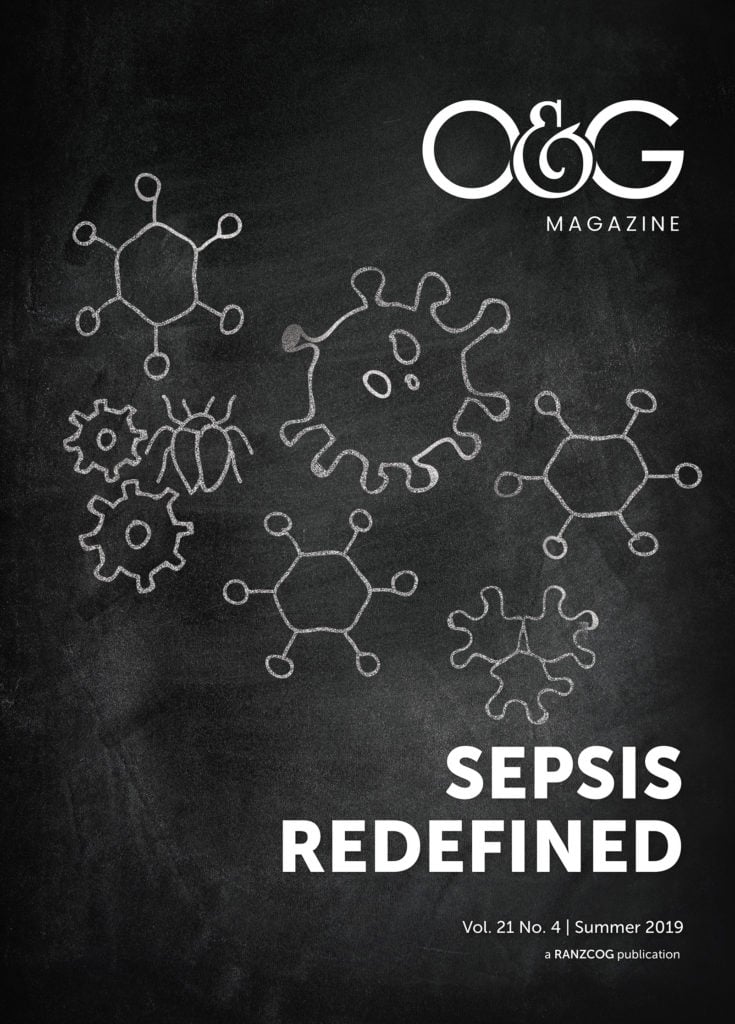Sepsis is life-threatening organ dysfunction caused by a dysregulated host response to infection.1 It is a preventable cause of maternal morbidity and mortality. In Australia, sepsis was the fourth-highest cause of maternal mortality between 2006 and 20162 and sepsis-related maternal mortality has been increasing.3
In the UK, reviewers identified substandard care as a factor in 63 per cent of sepsis-related maternal mortality cases, most often involving a delay in recognition or management, particularly on obstetric units.4 The physiological changes of pregnancy may mask the early signs of sepsis, the changes in labour may make the clinical picture more difficult to interpret and disease progression may be more rapid compared to non-pregnant women,5 making recognition and management more difficult. We explore the recognition and management of the septic patient in labour.
Risk factors
Clinicians should be aware of risk factors for sepsis in labour:6 7 8 9
- Obesity
- Impaired immunity/immunosuppressant medication
- Anaemia
- Vaginal discharge
- Previous pelvic infection
- Previous Group B streptococcal infection
- Invasive procedures (such as amniocentesis)
- Cervical cerclage
- Prolonged rupture of membranes
- Prolonged labour
- Increased number of vaginal examinations
- Group A streptococcus infection in close contacts/family members
- Minority ethnic group origin
- Nulliparity
- Multiple gestation
- Comorbidities (diabetes, chronic renal disease, chronic liver disease, congestive heart failure)
- Aboriginal or Torres Strait Islander origin10
Assessment
Signs and symptoms
Women may experience fevers/rigors, diarrhoea or vomiting, rash, abdominal pain, offensive vaginal discharge, a productive cough or urinary symptoms.5
Clinical signs suggestive of sepsis include:11 12
- Pyrexia
- Hypothermia
- Tachycardia
- Tachypnoea
- Hypoxia
- Hypotension
- Oliguria
- Impaired consciousness
- Fetal distress
- Failure to respond to treatment
These signs, including pyrexia, may not always be present and are not necessarily related to the severity of sepsis.13
Maternal vital signs should be recorded regularly on maternity-specific charts to guide assessment and ongoing management. A thorough neurological, cardiac, respiratory, abdominal, uterine and pelvic examination should be performed to determine the underlying cause.
Scoring systems
The Sequential (sepsis-related) Organ Failure Assessment (SOFA) score has been shown to reliably identify patients who have higher morbidity and mortality,14 but has not been validated in pregnant women. The score uses clinical and laboratory parameters, the Glasgow Coma Scale and the use of inotropes and/or vasopressors to assess organ dysfunction.
The quick SOFA (qSOFA) only uses clinical parameters and is therefore useful to screen women. We recommend the use of the obstetrically modified qSOFA (omqSOFA) (Table 1) in the first instance. End organ dysfunction is defined as an acute change in the total score of more than 2 points where the baseline score is assumed to be 0 if there were no prior concerns. The obstetrically modified SOFA (omSOFA) (Table 2) should be used subsequently for a more thorough assessment.
Table 1. Obstetrically modified qSOFA (omqSOFA) score.
Score |
||
| Parameter | 0 | 1 |
| Systolic blood pressure | ≥ 90 mm Hg | < 90 mm Hg |
| Respiratory rate | < 25 breaths per minute | ≥ 25 breaths per minute |
| Altered mentation | Alert | Not alert |
Table 2. Obstetrically modified SOFA (omSOFA) score.
Score |
|||
| Parameter | 0 | 1 | 2 |
| Respiration PaO2/FIO2 |
≥ 400 | 300 – < 400 | < 300 |
| Coagulation Platelets x 106/L |
≥ 150 | 100 – 150 | < 100 |
| Liver Bilirubin (µmol/L) |
≤ 20 | 20 – 32 | > 32 |
| Cardiovascular Mean arterial pressure (mm Hg) |
MAP ≥ 70 | MAP < 70 | Vasopressors required |
| Central nervous system | Alert | Rousable by voice | Rousable by pain |
| Renal Creatinine (µmol/L) |
≤ 90 | 90 – 120 | > 120 |
Management
Sepsis is a medical emergency. Treatment and resuscitation should begin immediately, ideally within the first hour, the ‘golden hour’.15 Investigations and management should be performed concurrently.
Investigations
First-line investigations include:16
- Blood cultures: at least two sets should be obtained from different sites. Cultures should be obtained prior to antibiotic administration but should not delay antibiotic administration.
- Other cultures: a urine microscopy, culture and sensitivity (MCS) should be obtained. Amniotic fluid MCS, nasopharyngeal swabs, vaginal swabs and stool cultures should be obtained where clinically indicated.
- Arterial blood gas: this will detect acidosis, hypoxaemia and provide a lactate.
- Lactate: increased levels are caused by tissue hypoperfusion and levels greater than 2 mmol/L are associated with an increased mortality risk.
- Full blood count
- Coagulation studies
- Urea, electrolytes and creatinine: abnormal electrolytes, elevated urea and creatinine may be seen in sepsis. These should be measured at baseline and until the patient improves.
- Liver function test: this should be performed as a baseline test and may be elevated if sepsis is arising from hepatic or perihepatic infections, or affecting hepatic blood flow and metabolism.
- Chest x-ray: imaging may need to be deferred to the immediate postpartum period depending on the stage of labour. If there is strong clinical suspicion of a respiratory source, targeted treatment should be commenced.
- Methicillin-resistant Staphylococcus aureus (MRSA) swabs should be performed. The MRSA status will facilitate optimisation of the antibiotic regime.
Further investigations (such as lumbar puncture, echocardiogram, imaging of the chest and/or abdomen) should be considered, depending on the stage of labour, but may need to be deferred.
Management
A multidisciplinary approach including obstetricians, neonatologists, intensivists, microbiologists, physicians and anaesthetists is required. The key principles include:17 18 19
- Antibiotics: broad spectrum antibiotics should be administered within one hour. Mortality can increase by 8 per cent for each hour of delay.20
- Fluid resuscitation: initial administration of 1–2 L of crystalloid is vital to restore the circulating volume, treat hypotension and improve tissue perfusion.
- Vasopressors: these should be used for hypotension that is not responding to fluid resuscitation or where fluid resuscitation is inappropriate.
- Targeted treatment: once a source has been identified, targeted antibiotic therapy should be commenced.
Fetal wellbeing should be assessed simultaneously with continuous electronic fetal monitoring. Any changes in the CTG should prompt re-assessment of the mother. Resuscitation will improve uteroplacental perfusion and the fetal condition.
Anaesthetic considerations for the septic woman in labour include:
- Neuraxial blocks: these should only be undertaken after careful consideration due to the increased risk of complications.
- General anaesthesia: if required, increased haemodynamic instability should be anticipated.
Delivery
Sepsis is not an indication to expedite delivery unless the source is thought to be intrauterine or delivery will facilitate improved management attempts. Otherwise, there is no evidence that delivery improves maternal outcomes. Additionally, delivery in the context of maternal instability increases maternal and fetal mortality rates.21 Delivery should be expedited for the usual obstetric and fetal indications.
Postpartum management
Women should be cared for in an intensive care setting with infection control measures in place. Ongoing antibiotic treatment should be guided by the clinical response. Thromboprophylaxis with low-molecular-weight-heparin should be administered. If a micro-organism is identified, this should be communicated to the neonatologists to guide the neonate’s antibiotic treatment.
References
- Singer M, Deutschman CS, Seymour CW, et al. The Third International Consensus Definitions for Sepsis and Septic Shock (Sepsis-3). JAMA. 2016;315:801-10.
- Australian Institute of Health and Welfare. Maternal Deaths in Australia 2016. Available from: www.aihw.gov.au/reports/mothers-babies/maternal-deaths-in-australia-2016/contents/report.
- Australian Institute of Health and Welfare. Maternal Deaths in Australia 2008–2012. Available from: www.aihw.gov.au/getmedia/07bba8de-0413-4980-b553-7592089c4c8c/18796.pdf.aspx?inline=true.
- Knight M, Kenyon S, Brocklehurst P, et al; On behalf of MBRRACE-UK. Saving Lives, Improving Mothers Care—Lessons learned to inform future maternity care from the UK and Ireland Confidential Enquiries into Maternal Deaths and Morbidity 2009–2012. Oxford (UK): National Perinatal Epidemiology Unit, University of Oxford; 2014.
- Pasupathy D, Morgan M, Plaat FS, Langford KS. Royal College of Obstetricians and Gynaecologists. Bacterial Sepsis in Pregnancy. Green-Top Guideline No. 64a. 2012. 1st Ed.
- Lewis, G. The Confidential Enquiry into Maternal and Child Health (CEMACH). Saving Mothers’ Lives: reviewing maternal deaths to make motherhood safer 2003–2005. The Seventh Report on Confidential Enquiries into Maternal Deaths in the UK. 2007. London: CEMACH.
- Cantwell R, Clutton-Brock T, Cooper G, et al for Maternal and Child Enquiries (CMACE). Saving Mother’s Lives: reviewing maternal deaths to make motherhood safer: 2006–2008. BJOG. 2011;118(suppl 1):1-203.
- Kramer HM, Schutte JM, Zwart JJ, et al. Maternal mortality and severe morbidity from sepsis in the Netherlands. Acta Obstet Gynecol Scand. 2009;88(6):647-53.
- Bauer ME, Bateman BT, Bauer ST, et al. Maternal sepsis mortality and morbidity during hospitalization for delivery: temporal trends and independent associations for severe sepsis. Anesth Analg. 2013;117(4):944-50.
- Australian Institute of Health and Welfare. Maternal Deaths in Australia 2008–2012. Available from: www.aihw.gov.au/getmedia/07bba8de-0413-4980-b553-7592089c4c8c/18796.pdf.aspx?inline=true.
- Pasupathy D, Morgan M, Plaat FS, Langford KS. Royal College of Obstetricians and Gynaecologists. Bacterial Sepsis in Pregnancy. Green-Top Guideline No. 64a. 2012. 1st Ed.
- Society for Maternal Fetal Medicine, Plante LA, Pacheco LD, Louis JM. SMFM Consult Series #47: Sepsis During Pregnancy and the Puerperium. Am J Obst Gynaecol. 2019;220(4):B2-10.
- Pasupathy D, Morgan M, Plaat FS, Langford KS. Royal College of Obstetricians and Gynaecologists. Bacterial Sepsis in Pregnancy. Green-Top Guideline No. 64a. 2012. 1st Ed.
- Seymour CW, Liu VX, Iwashyna TJ, et al. Assessment of clinical criteria for sepsis: For the third international consensus definitions for sepsis and septic shock (sepsis-3). JAMA. 2016;315(8):762-74.
- Bowyer L, Robinson H, Barrett H, et al. SOMANZ guidelines for the investigation and management sepsis in pregnancy. ANZJOG. 2017;57(5):540-51.
- Bowyer L, Robinson H, Barrett H, et al. SOMANZ guidelines for the investigation and management sepsis in pregnancy. ANZJOG. 2017;57(5):540-51.
- Pasupathy D, Morgan M, Plaat FS, Langford KS. Royal College of Obstetricians and Gynaecologists. Bacterial Sepsis in Pregnancy. Green-Top Guideline No. 64a. 2012. 1st Ed.
- Society for Maternal Fetal Medicine, Plante LA, Pacheco LD, Louis JM. SMFM Consult Series #47: Sepsis During Pregnancy and the Puerperium. Am J Obst Gynaecol. 2019;220(4):B2-10.
- Bowyer L, Robinson H, Barrett H, et al. SOMANZ guidelines for the investigation and management sepsis in pregnancy. ANZJOG. 2017;57(5):540-51.
- Kumar A, Roberts D, Wood KE, et al. Duration of hypotension before initiation of effective antimicrobial therapy is the critical determinant of survival in human septic shock. Crit Care Med. 2006;34(6):1589-96.
- Sheffield JS. Sepsis and septic shock in pregnancy. Crit Care Clin. 2004;20(4):651-60.






Leave a Reply